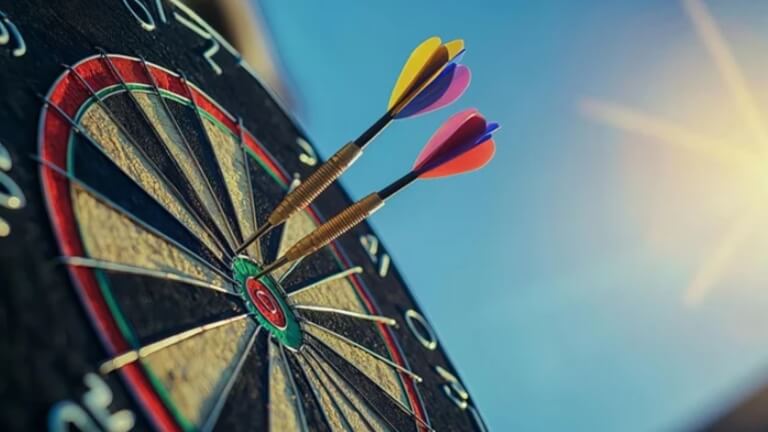If you’re new to darts, the regulations could be a little confusing and require some clarification. You may be worried about how to score in darts. To want to understand the rules of darts better and let you know how to play it easily.
The Darts Regulation Authority (DRA) was established in 2001 to ensure that darts games are properly managed and played. The DRA works closely with major companies like the Professional Darts Corporation (PDC) to uphold guidelines, control player subjects, and keep the sport’s popularity.
Description of the Score in Darts
In darts, a player loses their turn after three darts and aims to get as high a score as possible with each turn by throwing at a dartboard. The dartboard is split into numbered segments, valued at 1-20 points each, with further rings for doubles and triples. It is worth 50 points for the inner bullseye and the outer bullseye scores marks of 25 points.
The most popular game format is “501,” in which players begin with 501 points and subtract their scores, aiming to reach zero but ending on a double. Another well-known game called “301” has similar rules, but you start at 301. Precision and tactics are a must here, in particular for maximum scores (so-called 180s—three triple 20s) and, of course, hitting the necessary double to finish off the game.
Today we will try to understand how to score in darts as a game with 501.
The Player and Board’s Positions
Whether you’re a beginner or an experienced player, understanding the correct placement of both the player and the dartboard is crucial for achieving optimal performance.
How are the Players Standing?
Specifically in darts for 501, players stand behind a line known as ‘oche’ and its 7 feet 9.25inch (2.37 meters) while for steel-tip games. The position that the player takes is very essential in shooting the ball and getting a constant shot. Commonly, players use side-on or slight side-on posture as far as comfortable and throwing approach is concerned.
In side-on standing the player stands with the dominant foot perpendicular to the board, squarely on the oche line with the body sideways for balance and to give a clear line when throwing the bean bag. When the swing is side-on as described above, the front foot is turned inwards so that the body is less tense.
The non-dominant foot is placed behind to maintain balance during the movement. Baltimore generally minimizes movement of the shoulder area and maintains the elbow of the throwing arm with a view of aiming at the dart while releasing it smoothly.
How high is the Dartboard?
The official regulation height of a dart board is 5 feet 8 inches or (1.73 meters) from the floor to the center of the bulls-eye. This measurement is established by the official dart authorities such as the PDC and WDF, to keep standards in all tournaments to be met. There is an oche to which the dartboard must be affixed correctly, with its face plane to the oche.
The work of Dartboard Number System
A standard dartboard has 20 different sections, each with a certain number of points. These sections don’t go in order but are set up in a special way to make the game more challenging and strategic. The numbers on the board are:
Anti-Clock wise serially 20, 5, 12, 9, 14, 11, 8, 16, 7, 19, 3, 17, 2, 15, 10, 6, 13, 4, 18, 1.
Each numbered section of the dartboard has three distinct areas: the single, double, and triple rings. These areas increase the complexity of the scoring system, making strategy an essential part of gameplay.
Single Ring
In darts, the single ring means the regular part of each numbered area on the dartboard. When a dart lands in this part, it gets the exact number of points it hits. For example, if a dart lands in the single 20 area, then it scores 20 points. Unlike the double or triple rings, the single ring gives a simple score and is important in all darts games, like 501.
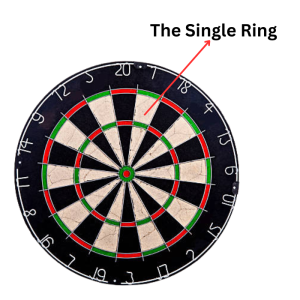
Double Ring
The double ring in darts is a thin ring on the outer part of the dartboard. When a dart hits this ring, it doubles the number it lands on. For example, if a dart land in the double 20 area, then scores 40 points. The double ring is very important in games like 501, where players need to hit a double to finish and win, making it a key target for ending games.

Triple Ring
The triple ring in darts is a narrow band between the bullseye and the double ring. If a dart lands here, it multiplies the value of the number hit by three. For example, if a dart lands in the single 20 area, then it scores 60 points. The triple ring is very important in many games, especially in 501, because it lets players score big points with fewer throws, making it a key target for skilled players.
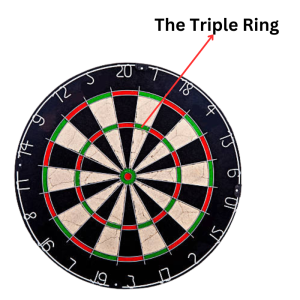
The Outer of Single Bull
The outer bull, also known as the “outer bullseye” or “single bull,” is the ring surrounding the central bullseye on a dartboard. It scores 25 points when hit, compared to the 50 points of the inner bullseye. The outer bull is often a strategic target for players, especially when aiming for a high checkout in games like 501, as it offers a valuable score while being easier to hit than the inner bullseye.
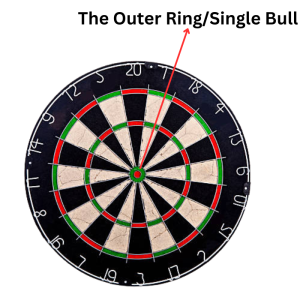
The Bullseye of Double Bull
The bullseye is the center of the dartboard, consisting of two rings. The inner bullseye scores 50 points, while the outer bullseye scores 25 points. Hitting the bullseye is a key goal in various darts games, as it can lead to high points or even determine victory in specific game formats. It’s a challenging yet rewarding target, crucial for players aiming to close out games with precision and skill.
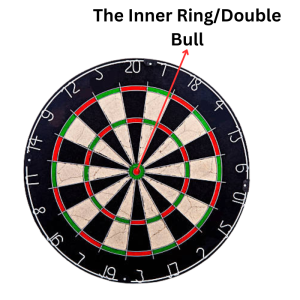
What is the Main Goal of Number 501?
The main goal in darts with a 501 starting score is to bring that number down to exactly zero by throwing darts at the board. After each turn, players take away their score from 501. To speed up the process, it’s helpful to aim for high-scoring spots like triple 20s.
To win, a player must end on a double (or the bullseye), which means their last dart must hit a double section to reach zero. It’s a game that needs both strategy and accuracy.
Darts Need in the game
In this game of darts, each player gets three darts for each turn. Players throw their darts at the board one after the other, and they have to use all three darts in each turn unless they reach a score of “zero”.
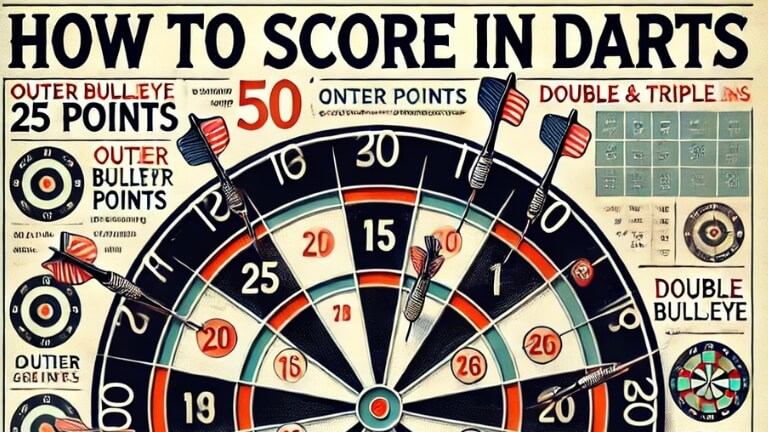
How to Score 501 in Rules of Darts
In the 501 game, each player begins with 501 points and tries to bring their score down to exactly zero. Players take turns, throwing three darts each round. The points a dart earns depend on where it lands on the dartboard. The dartboard has numbered sections from 1 to 20, and there are special rings: single, double, and triple.
A dart in a single section scores the number it hits, while a dart in the triple ring scores three times that number, and a dart in the double ring scores two times that number. For example, hitting a triple 20 scores 60 points, the highest possible score per dart.
End of the Game
To win or end of the game, a player must reduce their score to exactly zero and finish on a double or bullseye. If a player’s score goes below zero or they fail to finish on a double, their turn is void, and their score reverts to what it was at the beginning of the turn. Playing smart, like aiming for high-value areas like triple 20, is important to quickly lower the score and win.
How many Sets to Win Darts?
In darts, the number of sets required to win a match varies based on the tournament’s rules. In many professional events, like the PDC World Championship, matches are decided by a best-of-sets system. This means players must win more sets than their opponent to progress.
For instance, in a best-of-five sets match, a player needs to win three sets to be the winner. Each set is made up of several legs, and players must win more legs than their opponent within a set to claim it.
What is 3 Bullseyes in Darts Called?
Hitting three bullseyes in darts is commonly referred to as a “hat trick.” This achievement is impressive, as it requires three perfect throws into the bullseye area, with each bullseye worth 50 points.
A “hat trick” is considered a rare and notable feat, often celebrated by players and fans alike, demonstrating high skill and precision in hitting the most difficult target on the dartboard.
Why is Bullseye only 50?
The bullseye is worth 50 points because it’s the hardest and most valuable spot on the dartboard. In the past, the bullseye’s value was chosen to show how tough it is to hit, giving players a big reward for being accurate. The center bullseye gives 50 points, and the outer bullseye gives 25 points. This 50-point value keeps the game fair, making it a key target for players who want to end the game with a high score.

